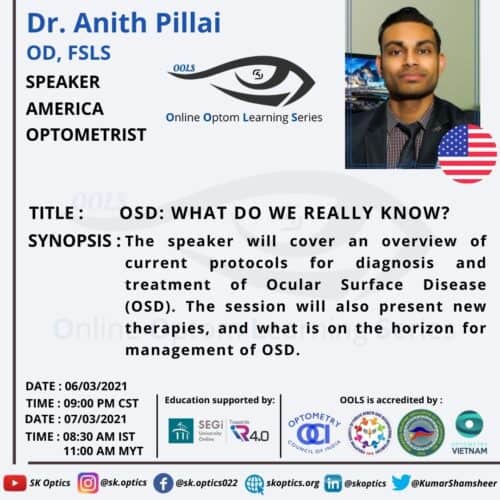
Dr. Anith Pillai, a practicing optometrist, and an anterior segment expert, begins by stating the DEWS II report highlights: loss of homeostasis, Hyperormolarity and Neurosensory abnormalities. We dive into the basics of diagnosing ocular surface conditions, with information on different methods and devices available to practitioners.
We learn in short about the clinical definitions of the ocular surface conditions before Dr. Pillai leads us into a detailed explanation of the following conditions
We learn the clinical definition for the following conditions
- Meibomian gland dysfunction (MGD)
- Definition
- Anatomy of the glands
- Pathophysiology
- Blepharitis
- Definition
- Demodex
Dr. Pillai then explains step-wise how to treat certain ocular surface conditions as per the DEWS II report.
- Step 1 Environmental control
- Step 2
- Step 3
- Step 4
Lastly, we learn about the specific recommendations that we should use to treat ocular surface disorders. Some of them are described as follows
- Artificial tears
- Omega 3s
- Hypochlorous acid
- Topical therapies
- Lipiflow
- Miboflow
- Microblepharoexfoliation
- iLux
- Tearcare
- Intense Pulse Light (IPL)
- Ocusoft Thermal 1 Touch
- Radio Frequency
- Low-Level Light Therapy (LLLT)
- At-home devices
- Scleral Lenses
- Amniotic membrane
- New Treatments
The session ends with an interesting question and answer segment with the live audience.
References
Papers
Craig JP, Nelson JD, Azar DT, Belmonte C, Bron AJ, Chauhan SK, de Paiva CS, Gomes JAP, Hammitt KM, Jones L, Nichols JJ, Nichols KK, Novack GD, Stapleton FJ, Willcox MDP, Wolffsohn JS, Sullivan DA. TFOS DEWS II Report Executive Summary. Ocul Surf. 2017 Oct;15(4):802-812.
https://pubmed.ncbi.nlm.nih.gov/28797892/
Nichols KK, Foulks GN, Bron AJ, Glasgow BJ, Dogru M, Tsubota K, Lemp MA, Sullivan DA. The international workshop on meibomian gland dysfunction: executive summary. Invest Ophthalmol Vis Sci. 2011 Mar 30;52(4):1922-9.
https://pubmed.ncbi.nlm.nih.gov/21450913/
Abelson M, Shapiro A, Tobey C. A Guide for Breaking Down Blepharitis. Rev of Ophthalmol. Feb 2011
https://www.reviewofophthalmology.com/article/a-guide-for-breaking-down-blepharitis
Argüeso P. Proteolytic activity in the meibomian gland: Implications to health and disease. Exp Eye Res. 2017 Oct;163:53-57.
https://pubmed.ncbi.nlm.nih.gov/28284957/
Groden LR, Murphy B, Rodnite J, Genvert GI. Lid flora in blepharitis. Cornea. 1991 Jan;10(1):50-3.
https://pubmed.ncbi.nlm.nih.gov/2019106/
Szkaradkiewicz A, Chudzicka-Strugała I, Karpiński TM, Goślińska-Pawłowska O, Tułecka T, Chudzicki W, Szkaradkiewicz AK, Zaba R. Bacillus oleronius and Demodex mite infestation in patients with chronic blepharitis. Clin Microbiol Infect. 2012 Oct;18(10):1020-5.
https://pubmed.ncbi.nlm.nih.gov/22114987/
Gao YY, Di Pascuale MA, Li W, Liu DT, Baradaran-Rafii A, Elizondo A, Kawakita T, Raju VK, Tseng SC. High prevalence of Demodex in eyelashes with cylindrical dandruff. Invest Ophthalmol Vis Sci. 2005 Sep;46(9):3089-94.
https://pubmed.ncbi.nlm.nih.gov/16123406/
Zhong J, Tan Y, Li S, Peng L, Wang B, Deng Y, Yuan J. The Prevalence of Demodex folliculorum and Demodex brevis in Cylindrical Dandruff Patients. J Ophthalmol. 2019 Apr 3;2019:8949683.
https://pubmed.ncbi.nlm.nih.gov/31073414/
Asbell PA, Maguire MG, Peskin E, Bunya VY, Kuklinski EJ; Dry Eye Assessment and Management (DREAM©) Study Research Group. Dry Eye Assessment and Management (DREAM©) Study: Study design and baseline characteristics. Contemp Clin Trials. 2018 Aug;71:70-79.
https://pubmed.ncbi.nlm.nih.gov/29883769/
Epitropoulos AT, Donnenfeld ED, Shah ZA, Holland EJ, Gross M, Faulkner WJ, Matossian C, Lane SS, Toyos M, Bucci FA Jr, Perry HD. Effect of Oral Re-esterified Omega-3 Nutritional Supplementation on Dry Eyes. Cornea. 2016 Sep;35(9):1185-91.
https://pubmed.ncbi.nlm.nih.gov/27442314/
Sosne G, Ousler GW. Thymosin beta 4 ophthalmic solution for dry eye: a randomized, placebo-controlled, Phase II clinical trial conducted using the controlled adverse environment (CAE™) model. Clin Ophthalmol. 2015 May 20;9:877-84.
https://pubmed.ncbi.nlm.nih.gov/26056426/
Bertino B, Blanchet-Réthoré S, Thibaut de Ménonville S, Reynier P, Méhul B, Bogouch A, Gamboa B, Dugaret AS, Zugaj D, Petit L, Roquet M, Piwnica D, Vial E, Bourdès V, Voegel JJ, Nonne C. Brimonidine displays anti-inflammatory properties in the skin through the modulation of the vascular barrier function. Exp Dermatol. 2018 Dec;27(12):1378-1387.
https://pubmed.ncbi.nlm.nih.gov/30290018/
Aluru SV, Agarwal S, Srinivasan B, Iyer GK, Rajappa SM, Tatu U, Padmanabhan P, Subramanian N, Narayanasamy A. Lacrimal proline rich 4 (LPRR4) protein in the tear fluid is a potential biomarker of dry eye syndrome. PLoS One. 2012;7(12):e51979.
More Relatable Blogs:
- https://visionscienceacademy.org/meibomian-gland-dysfunction-mgd-with-recent-advanced-technologies-diagnosis-and-management/
- https://visionscienceacademy.org/visual-ergonomics-there-is-a-lot-more-to-know/
- https://visionscienceacademy.org/contact-lens-associated-digital-eye-strain-des-latest-approach-towards-management-strategies/
